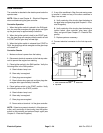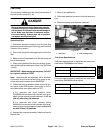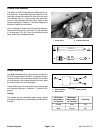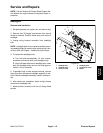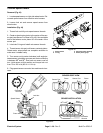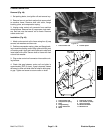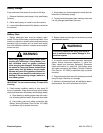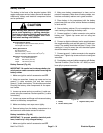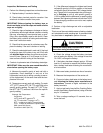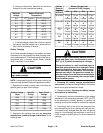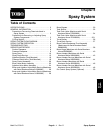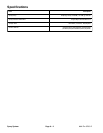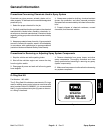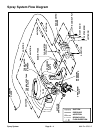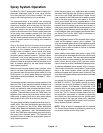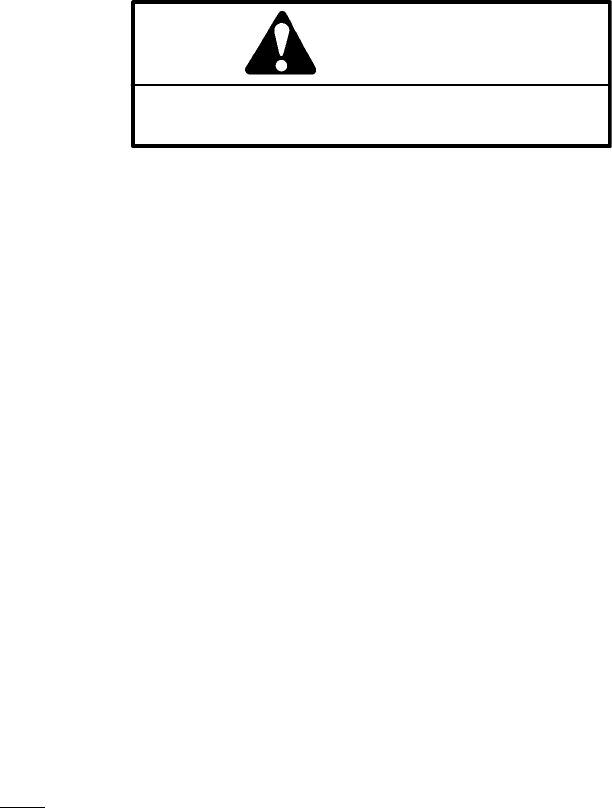
Inspection, Maintenance, and Testing
1. Perform the following inspections and maintenance:
A. Replace battery if cracked or leaking.
B. Check battery terminal posts for corrosion. Use
wire brush to clean corrosion from posts.
IMPORTANT: Before cleaning the battery, tape or
block vent holes to the filler caps and make sure the
caps are on tightly.
C. Check for signs of wetness or leakage on the top
of the battery which might indicate a loose or missing
filler cap, overcharging, loose terminal post, or over-
filling. Also, check battery case for dirt and oil. Clean
the battery with a solution of baking soda and water,
then rinse it with clean water.
D. Check that the cover seal is not broken away. Re-
place the battery if the seal is broken or leaking.
E. Check the electrolyte level in each cell. If the level
is below the tops of the plates in any cell, fill all cells
with distilled water between the minimum and max-
imum fill lines. Charge at 15 to 25 amps for 15 min-
utes to allow sufficient mixing of the electrolyte.
2. Conduct a hydrometer test of the battery electrolyte.
IMPORTANT: Make sure the area around the cells is
clean before opening the battery caps.
A. Measure the specific gravity of each cell with a
hydrometer. Draw electrolyte in and out of the
hydrometer barrel prior to taking a reading to warm–
up the hydrometer. At the same time take the tem-
perature of the cell.
B. Temperature correct each cell reading. For each
10
o
F (5.5
o
C) above 80
o
F (26.7
o
C) add 0.004 to the
specific gravity reading. For each 10
o
F (5.5
o
C) be-
low 80
o
F (26.7
o
C) subtract 0.004 from the specific
gravity reading.
Example: Cell Temperature 100
o
F
Cell Gravity 1.245
100
o
F minus 80
o
F equals 20
o
F
(37.7
o
C minus 26.7
o
C equals 11.0
o
C)
20
o
F multiply by 0.004/10
o
F equals 0.008
(11
o
C multiply by 0.004/5.5
o
C equals 0.008)
ADD (conversion above) 0.008
Correction to 80
o
F (26.7
o
C) 1.253
C. If the difference between the highest and lowest
cell specific gravity is 0.050 or greater or the lowest
cell specific gravity is less than 1.225, charge the bat-
tery. Charge at the recommended rate and time giv-
en in Charging or until all cells specific gravity is
1.225 or greater with the difference in specific gravity
between the highest and lowest cell less than 0.050.
If these charging conditions can not be met, replace
the battery.
3. Perform a high–discharge test with an adjustable
load tester.
This is one of the most reliable means of testing a battery
as it simulates the cold–cranking test. A commercial bat-
tery load tester is required to perform this test.
CAUTION
Follow the battery tester manufacturer’s instruc-
tions when using a battery tester.
A. Check the voltage across the battery terminals
prior to testing the battery. If the voltage is less than
12.4 VDC, recharge the battery.
B. If the battery has been charged, apply a 150 amp
load for 15 seconds to remove the surface charge.
Use a battery load tester following the manufactur-
er’s instructions.
C. Make sure battery terminals are free of corrosion.
D. Measure the temperature of the center cell.
E. Connect a battery load tester to the battery termi-
nals following the battery tester manufacturer’s
instructions. Connect a digital multimeter to the
battery terminals.
F. Apply a test load of one half the Cranking Perfor-
mance (see Battery Specifications) rating of the bat-
tery for 15 seconds.
G. Take a voltage reading at 15 seconds, then re-
move the load.
Electrical System
Page 5 – 32
Multi Pro 5700–D



